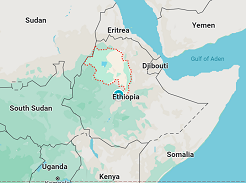By Anwar Hussen Mohammed – The fragile peace in Ethiopia was shattered in August 2023 as fighting erupted in the Amhara region, a critical contributor to the nation’s economic well-being. This new conflict, on top of the ongoing political tension and conflict in Tigray, threatens to deliver a devastating blow to Ethiopia’s hard-won economic gains.
To this day, the fighters in Amhara region, known as Fano, are fighting against the Ethiopian army. Just like the previous deadly war in Tigray Region, the war has been affecting negatively the overall economy of the region, the livelihoods of the people in the area, and the country’s socioeconomic and political atmosphere in general.
Before we look into the impacts of the war on the overall economy of the country, let’s see the major contributions of Amhara region to the national economy of Ethiopia. The Amhara Region of Ethiopia makes several significant contributions to the national economy in various sectors:
Agriculture: The Amhara Region is one of the major agricultural regions in Ethiopia, known for its fertile land and diverse agricultural production. It contributes significantly to the national production of crops such as cereals (wheat, barley, teff), pulses (beans, lentils), oilseeds (sesame), and various fruits and vegetables. Agriculture remains a primary livelihood for a large portion of the population in the region.
Industry: The region hosts various industrial activities, including manufacturing and agro-processing. There are factories and plants processing agricultural products such as grains and oilseeds, contributing to the industrial output of the country.
Hydropower: The Amhara Region is home to several major rivers and potential hydroelectric power sources. Hydroelectric dams like the Grand Ethiopian Renaissance Dam (GERD), although controversial and primarily impacting the Blue Nile Basin, are significant infrastructure projects that aim to enhance Ethiopia’s electricity generation capacity and contribute to the national energy grid.
Tourism: The region has several cultural and historical sites that attract tourists both domestically and internationally. Historical places such as Lalibela (known for its rock-hewn churches), Bahir Dar (on the shores of Lake Tana), and Gondar (known for its medieval castles and churches) are major tourist destinations. The tourism sector contributes to the regional and national economy through hospitality services, tour guiding, and related businesses.
Trade and Commerce: The Amhara Region serves as a hub for trade and commerce due to its strategic location and connection to major transportation routes. Cities like Bahir Dar and Gondar are important centers of trade, facilitating the exchange of goods and services between the region and other parts of Ethiopia as well as neighboring countries.
Education and Healthcare: The region’s investment in education and healthcare infrastructure contributes to human capital development, which is crucial for economic growth and productivity at both regional and national levels.
Overall, the Amhara Region plays a vital role in Ethiopia’s economy through its agricultural productivity, industrial activities, hydroelectric potential, tourism attractions, trade, and social infrastructure development. These contributions help support the livelihoods of its population and contribute to the broader economic development goals of Ethiopia.
Agricultural Powerhouse: Amhara is a major producer of staples like wheat and teff, Ethiopia’s nation next to Oromia Region. The region’s fertile lands contribute significantly to food security for the entire nation.
Trade and Transport Hub: Amhara sits astride key trade routes, facilitating the movement of goods within Ethiopia and to neighboring countries. This role is crucial for overall economic activity.
Investment Destination: Amhara has attracted significant investment in recent years, particularly in the flower industry, which is a major foreign exchange earner for Ethiopia.
The War’s Economic Toll:
Disrupted Agriculture: Fighting has displaced farmers, damaged agricultural infrastructure, and hampered planting and harvesting seasons. This threatens food production not only in Amhara but across Ethiopia, potentially leading to shortages and price hikes.
Trade Disruption: The conflict has disrupted transportation networks, making it difficult to move goods within Amhara and across the region. This hurts businesses, slows down economic activity, and hinders market access for Amhara’s agricultural products.
Investment Flight: The instability caused by the war in Amhara Region has scared away investors. The flower industry, a significant source of income, has been particularly affected, with exports coming to a standstill.
Ripple Effects Across Ethiopia:
The economic woes in Amhara have cascading effects on the entire nation:
Food Price Inflation: Disruptions to Amhara’s agricultural production contribute to food scarcity nationwide, pushing up food prices and impacting Ethiopians’ purchasing power.
Strained National Budget: The government is forced to divert resources towards the war effort, taking away funds from critical development projects and social services.
Investor Uncertainty: The ongoing conflict discourages foreign investment across Ethiopia, further hindering economic growth prospects.
The Road to Recovery:
A swift and peaceful resolution to the conflict in Amhara is vital to get Ethiopia’s economy back on track. Rebuilding damaged infrastructure, restoring agricultural production, and creating a secure environment for businesses are crucial steps towards economic recovery.
Ethiopia can ill-afford another war. The economic damage inflicted on Amhara threatens to derail the nation’s progress and plunge millions into hardship. Peace and stability are the cornerstones for rebuilding a stronger and more resilient Ethiopian economy.

